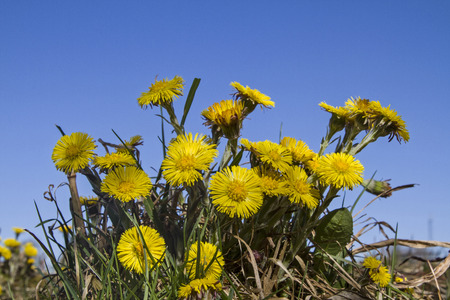Coltsfoot - Tussilago farfara

Common Names: Coltsfoot, Horsehoof, Foalswort, Bull's Foot, Coughwort, Ass's Foot, Tussilago farfara, Tussilago, Farfara, European Coltsfoot, British Coltsfoot, Latin: Tussilago farfara, Origin: Europe, International: Coltsfoot
Latin Name: Tussilago farfara
Origin: Africa, Asia, Australia, Europe, North America
Short Introduction
Coltsfoot thrives in clayey, calcareous, and lightly moist soils in fully sunny locations. It often appears as a pioneer plant on ruderal sites, embankments, dumps, pastures, fields, ditches, quarries, and more. Not only in the Czech Republic but throughout the temperate zone, Coltsfoot is found in abundance from lowlands up to mountainous areas, often growing almost like a weed wherever it is given a chance. Its seeds germinate rapidly—a few hours after sowing—and every piece of root can sprout a new plant. For intentional cultivation, sow in moist soil in summer or propagate by division or cuttings in autumn. Flowers are collected in the spring during dry weather in the afternoon and dried in the shade at around 40°C. Once dried, the flower is odorless with a bitter taste.
Detailed Description
A traditional herb for flu, cold, and respiratory ailments.
Botanical Information
Coltsfoot (Tussilago farfara) is a perennial spring herb with a long (up to 1 meter), creeping underground rhizome. From the rhizome emerges a scaly, thin, upright stem about 5–15 cm tall. The simple leaves, with long stalks, a broadly palmate blade, and heart-shaped, lobed form, appear only after flowering, forming a basal rosette. The leaf margins are toothed and, when young, felty on both sides—later becoming hairless on the upper side. At the top of each stem is a single golden-yellow flower head, 2–3 cm wide, composed of many tubular and ray florets. In lower altitudes, the flower appears from March to April; in mountainous regions, it can be seen until August. The fruit is a small (3–5 mm), fluffy achene.
Origin and Distribution
Coltsfoot is native to Europe, where it is widely distributed, especially in the northern half of the continent. It is rare on the western coast but stretches into Asia—from the Caucasus through Iran and India, northward across Siberia to the Far East. It also occurs naturally in mountainous regions of North Africa and has been introduced by humans to North America. In the Czech Republic, Coltsfoot grows in high density from lowlands to mountains.
Usage / Dosage
Coltsfoot has been valued since ancient Greece and Rome for its use in supporting respiratory system health. Pliny the Elder recommended Coltsfoot leaf as a tobacco alternative for asthmatic complaints, bronchial illnesses, and cough. Traditionally, the plant hung above the doors of apothecaries and physicians, serving as their symbol. Coltsfoot remains a well-known folkloric harbinger of spring, with ongoing spiritual significance and use in magical practices.
American and European health authorities, in response to substantial evidence, have issued statements supporting Coltsfoot’s benefit for normal respiratory function via its influence on the immune system. Studies show that Coltsfoot flower extracts can stop certain viral replications (in vitro), possess cytoprotective and neuroprotective properties, and protect cells from oxidative stress by neutralizing harmful radicals. Further research indicates that a sesquiterpene called tussilagonone, isolated from Coltsfoot flower, has strong anti-inflammatory effects, reducing inflammatory markers (such as iNOS, nitric oxide, prostaglandin E2, nuclear factor beta, and cyclooxygenase-2) in specialized models. Certain flavonoids from Coltsfoot have demonstrated a significant antitussive (cough-suppressing) effect, as well as expectorant properties. Other studies point to antitubercular effects through reduction of Mycobacterium tuberculosis bacteria.
Traditional Medicine
In folk medicine, Coltsfoot is used for asthma, cough suppression, expectorant support, inflammation of the nasopharynx, congestion, pneumonia, hoarseness, and to support antidiabetic therapy. Externally, it’s applied for eczema or used as a gargle for inflammation of the mouth and throat. Herbal tea is taken for rheumatism, gout, and pain generally. Coltsfoot flowers possess disinfectant and anti-inflammatory effects, commonly used for upper respiratory infections both alone or in blends. They also have a mild diuretic and anti-asthmatic effect. In both European and Asian folk medicine, Coltsfoot is used for diverse indications including asthma, sore throat, cough, bronchitis, laryngitis, breathlessness, and wheezing.
Limitations
Due to the presence of pyrrolizidine alkaloids in Coltsfoot flowers, long-term use is not advised, even though their levels are very low and further reduced by drying. Herbal tea mixtures with Coltsfoot should not exceed 15% Coltsfoot content. In some countries, it cannot be freely sold as a tea herb.
Active Compounds
Coltsfoot flowers are rich in flavonoids, mucilage-forming substances, bitter glycosides, tannins, xanthophyll pigments, minor essential oils, organic acids (including gallic, lactic, malic, tartaric, caffeic, isochinonic, quinonic, trans-cinnamic, hydroxybenzoic, and coumaric acids), choline, quercetin, isoquercetin, kaempferol, loliolide, monosaccharides and polysaccharides (notably inulin). The leaves have a similar but less concentrated spectrum of these compounds. The flowers are also a notable source of zinc and potassium. Sesquiterpenoids (like tussilagon and various petanone derivatives) are present in different amounts, as are pyrrolizidine alkaloids (senkirkin, tussilagin, senecionin), which limit safe intake.
Traditional Dosage
The dried flower is the main herbal part used. Infuse 2 teaspoons of dried flower in boiling water, steep for 10 minutes, and drink 1–3 times a day. For decoction, mix 1 teaspoon of flowers with 250 ml of water, boil briefly, and steep for 15 minutes; take 1–2 times daily in sips, use externally as a wash for skin sensitivity, or as a gargle. Inhale steam from a heaping tablespoon of flowers added to boiling water. For painful joints, inflammations, swellings, vein inflammations, and ulcers, use compresses of soaked and lightly bruised Coltsfoot flowers. Coltsfoot honey is made by simmering about 250 g of flowers with 1 kg sugar and lemon, helpful as an expectorant. Traditional teas for expectoration combine Coltsfoot with mullein and primrose, or Coltsfoot with thyme, chamomile, anise, and thyme.
